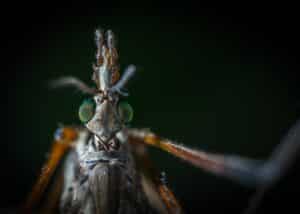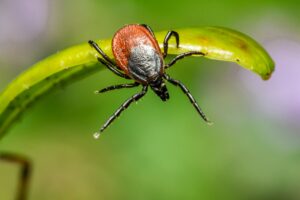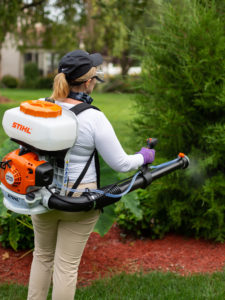Anyone who has been a mosquito control professional for any length of time can tell you, sometimes the effectiveness of a treatment plan varies from house to house or can vary based on the time of year and the weather.
We have written in previous blogs about just how effective barrier mosquito treatments are and how they can be a very solid intervention to reduce nuisance biting mosquitoes.
Seems logical, but sometimes it is good to take a step back and look more closely at mosquito biology and mosquito – climate interactions to think about how we can adjust our programs as needed when we hit a rough spot.
How do barrier mosquito treatments work?
In general with barrier treatments, we treat the underside of foliage and other surfaces where mosquitoes rest. The mosquitoes land there, they pick up the material, they rub it on themselves, they die.
Many mosquitoes do not land in yards
Yes, it is crazy. Many mosquitoes do not land in a yard near the places where you are relaxing with your family.
So that kind of messes up our whole plan.
Just to get slightly nerdy for a couple of paragraphs.
In an awesome paper titled: “Flight distance of mosquitoes (Culicidae): A metadata analysis to support the management of barrier zones around rewetted and newly constructed wetlands” Piet F M Verdonschot & Anna Besse-Lototskaya did an awesome job looking at all the sources available documenting just how far various species of mosquitoes will fly in search of food. They did the research thinking about how far away from major breeding sites should we develop the land of residential use. BUT the results tell us a LOT of good info that will help us for backyard mosquito control.
Seriously, you should check out the paper. It is really cool.
Dozens of mosquito species will travel over a half-mile to look for a blood meal
Some types of salt marsh mosquitoes including Aedes taeniorhynchus will travel up to 20 miles. Or Aedes squamiger will travel 10-20 miles looking for a blood meal. After hatching they travel on the breeze, using very little of their own energy.
Practically speaking, many customers will be within a half-mile of a natural mosquito breeding area.
What about the neighbor with the "Tire, bucket, and bathtub collection"?
We have all been there, worked with a client, tried to help get their mosquito issue under control, but we just can’t figure out the issue. Then, it dawns on us, two houses down. There is THAT backyard. You know the backyard, its got a 87′ Buick on blocks, 35 buckets to collect rain water, and about 15 years of old tires. Or maybe it just has an old swimming pool that hasn’t been used in a decade. In these instances, you have expanded the list of possible breeding mosquitoes. If a house is even a neighbor or two away, almost every species of mosquitoes will venture that far looking for a blood meal. And on a warm summer night, your client sitting on their back deck will look like a filet mignon.
The resistance
Yes, I’m talking about pyrethroid resistance. Anyone reading this who knows me, can attest that I believe the widespread use of pyrethroids, both type I and type II, will eventually be really bad for us. To be fair, mosquito control is not the primary offender, Agriculture has used many more millions of gallons of those products than pest control over the last 30 years. But, in pest control, we have to be smart as we are dealing with the consequences.
Insecticide Resistance has been documented for most major classes of synthetic chemistry across a wide swath of genera.
I’m focusing on pyrethroids here because for the most part mosquito control pros only use pyrethroids and or PBO.
Also note, to date, I have not seen a documented case in the literature, of resistance to essential oil-based insecticides. Do I think it is possible someday to eventually develop? Of course, I do, I try to never bet against nature. I also think we are a long way from the prevalence of uses required to create resistance in a localized mosquito population. If we are smart with how we use these technologies we might be able to keep them as effective tools for a long time to come.
Sometimes, it's your product choice
If a customer is not near a natural mosquito breeding area, and their neighbors seem to be pretty responsible, and you are still having problems. It might be you.
If you are switching from Lambda-cyhalothrin, to Bifenthrin, to Permethrin, … That is like switching between different sizes and styles of hammers. If the mosquito population is resistant to pyrethroids, you need to move from a hammer to a chain saw, or an Ax. you need a different tool. In that case, I reccomend, Stop the Bites!, (of course I do, this is our blog.)
What can you do with those difficult properties?
We wrote a long blog last year and we talked about how homeowners can prevent mosquito bites.
All those same strategies apply to this situation. Advise the homeowner that they are going to need to create multiple lines of defense. Personal protection, fans, source reduction, and if possible, public health mosquito control.
If you are lucky enough to live in a place that has public health mosquito control, they can help with a lot of these problems. They can provide large-scale larviciding of breeding spots near the residence. They can also knock on the door of the resident down the street who refuses to take care of their breeding sites. They are allowed to do that because all of the mosquitoes they are breeding are public health pests and possibly endangering their neighbors.





